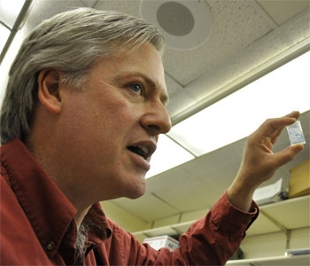Geology Faculty Earn Smithsonian Appointments, See Benefits for Students
NewsDr. John Haynes peers into the lens of a petrographic microscope to determine if the thin layers of rock he is looking at contains any volcanic material.
An assistant professor of geology and environmental science, Haynes is not working on a project for one of his classes, but rather research for the Smithsonian National Museum of Natural History. On Nov. 15, 2008, Haynes gained institutional affiliation as a research associate in the department of mineral sciences at the Smithsonian.
For 25 years, Haynes has worked with volcanic materials and has gained expertise in the subject. When the museum received a project involving a fossil tree that might be volcanic, Smithsonian scientists knew exactly who to call.
"I did postdoctoral research at NMNH in the department of mineral sciences in 1994-1995," said Haynes. "I have maintained connections with scientist there over the years."
With a three-year research associate appointment, Haynes is working with analytical equipment and thin sections to determine whether or not the rock is volcanic. The only way to know if a rock is volcanic is to study thin sections, Haynes said.
The sections consist of cubes of rock that have been cut, glued and ground to glass micro slides. Once the rock is ground down to .003 mm thick, light is able to pass through the minerals, enabling scientists to study what’s inside.

Once or twice a month during the school year, Haynes commutes to the museum in Washington, D.C. There, Haynes is part of a five-person team working on the fossil tree from an Iowa coal mine. On the team with Haynes is JMU junior Bonnie Ratkiewicz. By May 2010, Haynes plans to have papers completed and presented on the fossil tree.
In addition to his research position, Haynes has the honor of having two samples on permanent display in the Smithsonian. Two large rocks, one of shale and one of limestone, have been on exhibit since 1998. They are located in the case of sedimentary rocks labeled "water recycles rocks."
Haynes is not the only JMU professor to be appointed as a research associate. In November, Dr. Elizabeth Johnson, an assistant professor of geology, also gained Institutional affiliation with the Smithsonian. From 2003 until 2004, Johnson did her postdoctoral fellowship at the Smithsonian and is a specialist in studying volcanic rocks at high and low temperatures. Her work is important for climate purposes.
Through the technique of infrared spectroscopy, infrared light is shot through a mineral thin section and is absorbed. The infrared light allows Johnson to see the amount of water that is trapped in the crystal structure and ultimately how much water is in the magma.
"The more water in the magma, the more likely the volcano is to have an explosive eruption," Johnson explained. "It also allows you to see the history of the volcano and how the cycle works."
Johnson also is able to use the Smithsonian equipment such as an electron microprobe, which tells the chemistry of the minerals within the rock, and X-ray fluorescents, which tell the chemistry of the whole rock.
Haynes and Johnson say their appointments not only benefit their research, but their students as well.
Haynes hopes to work with three students and help them do research with the Smithsonian and the oil industry.
"Part of the expectations in a science department is to be doing research with students," said Haynes.
Johnson is working with four students at the Smithsonian on various projects ranging from water content in Yellowstone magma to researching a mysterious volcanic rock from Ireland.
"The whole idea is to involve the students; this is their research project as well," Johnson said. "It’s not only fun to see, but they are also learning what being a scientist is like."

